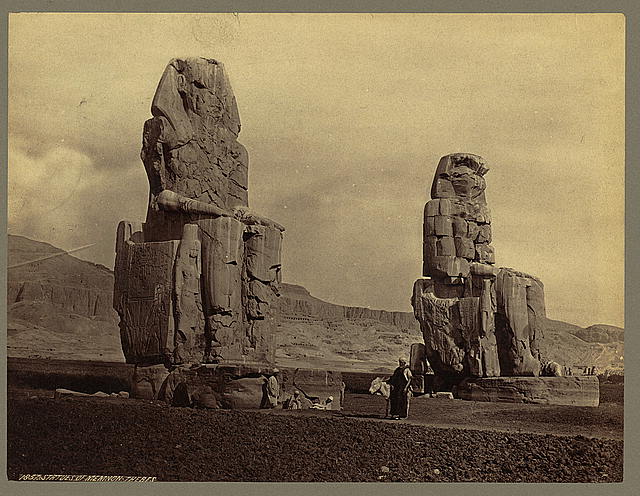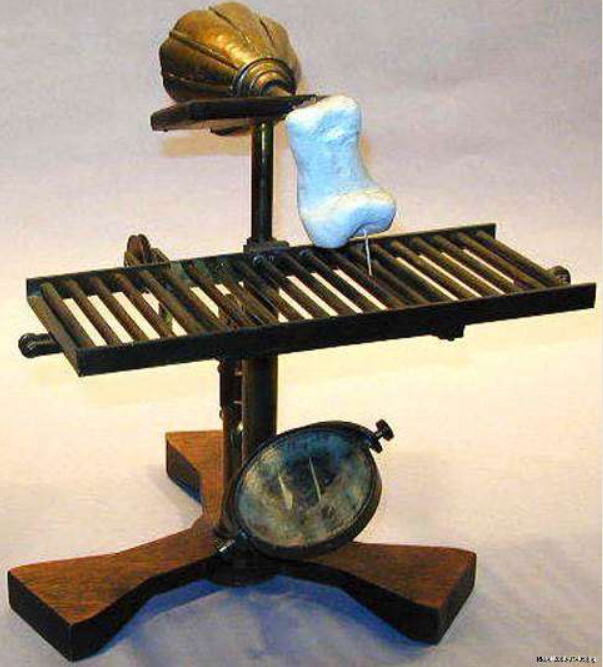Great inventions simply do not emerge out of thin air from an imaginative intellect. Scientific discovery emerges from previous works and a logical hunch or hypothesis. Inventors are influenced knowingly or unknowingly by centuries of scientific inquiry. Thomas Edison may have invented his Tin Foil Phonograph in 1877, but centuries of scientific research preceded his discovery. In a way, the individuals highlighted in this chapter helped invent the phonograph because previous discoveries by hardworking inquisitive individuals laid the groundwork and inspired Edison’s work.
The earliest known attempt to mechanically reproduce the human voice happened in 1490 B.C.E. It was the statue of Memnon at Thebes built by the eighteenth Egyptian dynasty. The great stone statue was believed to greet his mother the Goddess of the Dawn every morning. The sound was believed to have been produced through hidden air chambers. The statue no longer spoke after an earthquake in 27 C.E. The Roman Emperor Septimus Severus worked hard to restore the monument in 196 C.E., but the statue never spoke again.4

In all the sources I have come across on sound reproduction, Read and Welch are the only scholars I have come across trace sound reproduction this far back. I suspect other scholars have not included this story because much like Read and Welch noted, they question the vocal capacity of the statue. The Memnon statue may not provide conclusive evidence of sound reproduction, but this story has importance to the journey of sound because it was one of the earliest documented times humans imagined sound reproduction.
The legacy of Pythagoras is the next flashpoint in the study of sound.

David Morton’s book, Sound Recording: The Life Story of a Technology is my only sound reproduction source that tells of Pythagoras. Morton highlights that he was a 6th century B.C.E. Greek philosopher who studied music and the vibrations of stringed instruments.5
Morton’s brief explanation leaves one wondering what did Pythagoras do? What did his studies entail and what were his findings? If Pythagoras is essentially the originator of acoustics perhaps he should occupy a greater space in works on sound reproduction.
A Science & Education article, “From Music to Physics: The Undervalued Legacy of Pythagoras,” by Imelda Caleon and Subramaniam Ramanathan further explored who Pythagoras was. The main point they make is Pythagoras was the first to observe the laws of nature as mathematical representations. Even the most mundane aspects of life and the sounds he heard every day were internalized mathematically and could provide inspiration for sound experiments. One day he was listening to the blacksmith’s hammering, and he heard harmony emanating. When the hammers sounded consonant or pleasing, he realized that he heard ratios of whole numbers.
After this experience, he recreated it in two different experiments. The first was playing glass vases filled with different amounts of water. The other way was the creation of a stringed instrument named the monochord. It was one string stretched over a board with a bridge that could be moved. His homemade instrument helped him discover consonance “can be achieved when the string length ratios of the monochord involve the numbers 1, 2, 3 and 4. For instance, he noticed that two stretched strings, whose lengths are in the ratio 2:1, produced the same note an octave apart.”6
Pythagoras theorized that his finds related to the structure of the cosmos. He thought that each of the planets produces a sound when it moves around the sun. He thought people on Earth did not hear these tones because human ears had grown accustomed to them. Pythagoras also thought that the planets were arranged in a musical progression and that their spacing utilized ratios of whole numbers.
The idea of music in the cosmos was one that many later scholars failed to take seriously because Pythagoras failed to have strong supporting evidence. However, modern scientists are starting to think the cosmos indeed has a song. Caleon and Ramanathan found studies showing modern scientific instruments are detecting frequencies that are inaudible to the human ear.

Black Holes are “humming a sound 57 octaves below the middle keys in the piano.” The sun produces a frequency of approximately 100 MHz. Earth, and possibly Venus and Mars produce pitches due to oscillations in the atmosphere.7
Ultimately the first person we know about to have a scientific fascination with sound was a man captivated by the universe and all the sounds it makes. For this reason, Pythagoras is important, and it is unfortunate that he is not given a greater mention in works about sound reproduction. Pythagoras’s early acoustical work influenced centuries of scholars and clearly still has a bearing in the modern world. While generations of minds and societies built upon the foundation that Pythagoras set forth it was not until the early 18th century that acoustics was properly recognized as a scientific field.
Michael Chanan in his book, Repeated Takes: A Short History of Recording and Its Effects on Music, found that it was Joseph Sauveur, a French scientist, who organized the field. Chanan specifically cites the influence of Johannes Kepler, René Descartes, Marin Mersenne, and Vincent Galilei, Galileo’s Father.8 This work does not specifically mention Pythagoras but since he influenced the works of the listed scientists one could also assume that Sauveur found Pythagoras to be influential. One could also infer Galileo to be of interest as he continued his father’s work.
Read and Welch, Morton, and Chanan all emphasize European scholarship in the 18th and 19th century as pivotal to the creation of the phonograph. Read and Welch state “although the practical applications of scientific discoveries were made largely by Americans, the prerequisite acoustical and electrical science had been established principally by Europeans.”9
In the world of acoustics studies, Hermann Helmholtz discovered the laws of harmonics and wrote the landmark “On the Sensations of Tone” where he explains his findings and builds upon Pythagorean notions by further examining consonance and ratios of whole numbers.10

Jules Antoine Lissajous established the Lissajous curve, a series of sinusoidal curves created by harmonic resonance.11 Félix Savart created a toothed wheel that determined how many vibrations per second comprise different pitches.12
Notable studies involving electricity included Michael Faraday who discovered that in an electrical circuit, electricity flows due to variances within a magnetic field.13 Georg Ohm established “Ohms Law” which is the relationship between voltage, current, and resistance.14 Luigi Galvani became the father of bioelectricity.15 Bioelectricity studies the relationship between electromagnetic fields and living things.
The first significant leaps towards the creation of the phonograph were performed by a French scientist, Jean-Marie Constant Duhamel, and an English scientist Thomas Young. Morton and Read and Welch tell of Duhamel’s discovery.16 17 Duhamel created an apparatus of a pen attached to a tuning fork. Duhamel tapped the tuning fork near a sheet of paper and found that the pen traced the vibrations. It was the first time that there was visual evidence of a sound wave.
Morton found that Thomas Young took Durhamel’s experiment further in 1806.18 19 What Young did was fashion the same apparatus, but instead of tracing sound waves onto paper he traced them onto a wax coated cylinder. What is so interesting about Young’s work is wax cylinders etched with sound waves will be reprised later. Early cylinder records were made out of wax. I am unsure if Young’s wax cylinder inspired future discoveries or if the uses of wax cylinders by other scientists were purely coincidental.

The next etchings of sound waves were produced by the phonautograph. Most scholars perceive the phonautograph to one of the phonograph’s direct predecessors. The phonautograph was invented in 1856, by Édouard-Léon Scott de Martinville in France. Chanan states that the name means “sound-writer.”20 The device drew tracings of the sound waves, but it could not reproduce them. Chanan describes the device as:
The mechanism consisted in a membrane stretched of the small end of a cone hinged to a wooden lever: at the other end of the lever a pig’s bristle was suspended over glass or paper covered with lampblack, such that by speaking into the cone while the glass or paper was moved beneath the bristle, a tracing of the pattern of the sound waves would be produced.21

The phonautograph became a scientific research instrument. Chanan tells that the machine influenced Alexander Graham Bell’s work but the reader is not left with an impression of what the scientific community at large thought of the device.
Though numerous sources give the phonautograph a quick mention, it is Morton that highlights that this was a well-known device to mid-19th-century people. His work shows that this device was adopted by classrooms and laboratories in the United States starting in the 1860s. Even the Smithsonian Institution purchased one in 1866.22
As mentioned previously, the phonautograph made an impression on Alexander Graham Bell. His name is synonymous with the telephone, but Bell’s earlier work led to this discovery. Fashioning his phonautograph out of a cadaver’s ear was a step along the way to both the telephone and phonograph. Alexander Graham Bell called the device the“ear phonautograph.”23

Morton found that Bell created his ear phonograph in 1874 when he worked as a professor at Boston University and was a researcher studying sound and the deaf. Bell was inspired by demonstrations he observed at the Massachusetts Institute of Technology dealing visualizations of sound. One was an improved phonautograph by Charles Morey, and the other was a “manometric flame” by Rudolph Koenig.24 Koenig’s work let people visualize sound by a gas flame. He used sound waves to alter the shape of the flame.
Bell walked away from the demonstration thinking critically about what he had observed that day. When dealing with the same frequency neither the phonautograph or the manometric flame acted similarly. He deduced that both machines were inaccurately capturing sound waves. Drawing upon his studies, Bell perceived the ear as a mechanism and deemed that the ear would be the most correct and faithful way to record sound.25 Sometimes nature provides the greatest inspiration.
_______________________________________________________
4 Read and Welch, 1.
5 David L Morton, Sound Recording: The Life Story of a Technology (Baltimore, MD: Johns Hopkins University Press, 2006), 1.
6 Imelda Caleon and Subramaniam Ramanathan, “From Music to Physics: The Undervalued Legacy of Pythagoras,” Science & Education 17, no. 4 (2007): 450.
7 Ibid., 454.
8 Michael Chanan, Repeated Takes: A Short History of Recording and Its Effects on Music (London: Verso, 2000), 1.
9 Read and Welch, 2.
10 Hermann von Helmholtz, Alexander John Ellis, and Henry Margenau, On the Sensations of Tone as a Physiological Basis for the Theory of Music (New York: Dover, 2003).
11 Eric W. Weisstein, “Lissajous Curve,” Wolfram MathWorld: The Web’s Most Extensive Mathematics Resource, accessed July 3, 2017, http://mathworld.wolfram.com/LissajousCurve.html.
12 Thomas B. Greenslade, “Savart’s Wheel,” Kenyon College, accessed July 3, 2017, http://physics.kenyon.edu/EarlyApparatus/Acoustics/Savarts_Wheel/Savarts_Wheel.html.
13 “Michael Faraday,” Famous Scientists, last modified November 24, 2014, https://www.famousscientists.org/michael-faraday/.
14 “Georg Ohm,” Famous Scientists, accessed May 17, 2017, https://www.famousscientists.org/georg-ohm/.
15 “Luigi Galvani,” Famous Scientists, accessed May 17, 2017, https://www.famousscientists.org/luigi-galvani/.
16 Morton, Sound Recording, 2
17 Read and Welch, 6.
18 Morton, Sound Recording, 2.
19 I am unsure of how much time elapsed since Durhamel’s initial experiment. Neither Morton or Read and Welch list a date for Durhamel’s work.
20 Chanan, Repeated Takes, 23.
21 Ibid., 23.
22 Morton., 3.
23 Morton, Sound Recording, 4.
24 Ibid., 4.
25 Ibid., 4.

